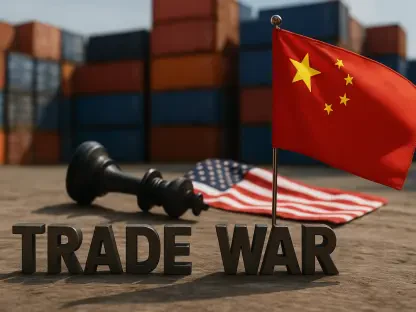The stock market today stands at a critical crossroads, shaped by seismic shifts in trade policy and monetary strategy that have sent ripples through Wall Street, creating an environment of uncertainty and opportunity. On a pivotal day marked by dramatic policy announcements, the financial landscape revealed stark contrasts, with the Nasdaq Composite surging to a record high while the Dow Jones Industrial Average faltered under mounting pressures. This split performance reflects a volatile mix of sweeping tariffs imposed by President Donald Trump on imports from nearly 200 countries and significant Federal Reserve developments that have both unsettled and energized investors. The tariffs, averaging an effective rate of 18.6%—the highest since 1933—have upended global trade dynamics, hitting companies like Toyota with projected losses in the billions while offering exemptions to tech firms investing in U.S. manufacturing. Meanwhile, Trump’s nomination of Stephen Miran to the Federal Reserve Board late in the trading session sparked a rally, hinting at stability amid economic uncertainty. As corporate earnings paint a mixed picture and labor market data raises red flags, the interplay of these forces demands a closer examination of their immediate and long-term effects on market behavior.
Beyond the headline numbers, broader economic indicators add layers of complexity to the day’s narrative, painting a multifaceted picture of the current financial landscape. Rising unemployment claims and disappointing jobs reports have intensified speculation about a Federal Reserve rate cut as early as September, while commodities like gold and cryptocurrencies like Bitcoin reflect a flight to alternative assets amid trade tensions. Sectoral trends further highlight disparities, with technology stocks thriving on policy carveouts and automotive industries grappling with new costs. As the market navigates this intricate web of policy-driven volatility, understanding the nuanced impacts of tariffs and Fed actions becomes essential for grasping the undercurrents steering investor sentiment.
Unpacking the Effects of Tariffs on Market Dynamics
Trade Barriers Reshaping Global Commerce
The introduction of extensive tariffs on imports from nearly 200 countries has sent shockwaves through global trade networks, fundamentally altering cost structures for countless businesses. Effective from the first minute of a recent trading day, these tariffs range between 10% and 50%, creating an average effective rate of 18.6%, a level not seen in nearly a century. For companies heavily reliant on international supply chains, the financial burden is immediate and severe. Toyota, for instance, has projected a staggering $9.5 billion impact on its operations due to its dependence on imports from regions like Japan, Canada, and Mexico. This policy has sparked fears of a broader trade war, with potential retaliatory measures from affected nations looming on the horizon. The disruption extends beyond individual firms, threatening to reshape global trade patterns as businesses reassess their sourcing strategies to avoid prohibitive costs, potentially leading to higher prices for consumers and squeezed profit margins for corporations.
While the tariffs pose significant challenges, certain sectors have found a silver lining through strategic exemptions designed to encourage domestic investment. Technology firms, particularly those in the semiconductor industry, have benefited from carve-outs tied to commitments for U.S.-based manufacturing. Companies like Nvidia and Taiwan Semiconductor have seen their stock prices climb as investors reward their alignment with national policy priorities. This disparity underscores a broader trend: sectors exposed to international trade face mounting headwinds, while those able to pivot toward domestic production gain a competitive edge. The immediate market reaction, with the Nasdaq climbing nearly 0.4% to a record high, reflects this optimism in tech, even as the Dow slipped 0.5% under the weight of trade-related concerns impacting industrial and consumer goods sectors. The uneven impact of these tariffs highlights the complexity of policy-driven market shifts.
Corporate Strategies Adapting to New Realities
In response to the tariff landscape, corporations are recalibrating their strategies to mitigate financial fallout, with some seizing opportunities where others see obstacles, and Apple stands out as a prime example of this adaptability. The company announced a $100 billion investment in U.S. manufacturing that not only shields it from tariff impacts but also positions it as a leader in aligning with governmental policy. This move, unveiled alongside President Trump at the White House, signals a potential wave of onshoring as firms seek to localize production to avoid import costs. Such strategic pivots could redefine competitive dynamics, rewarding companies that adapt swiftly while punishing those slower to respond. For investors, Apple’s gain in stock value post-announcement reflects confidence in its ability to navigate the new trade environment, setting a benchmark for others to emulate in the face of policy upheaval.
Conversely, not all companies are equipped to absorb or sidestep the tariff burden, facing tough choices that could ripple through the economy. Toyota’s warning of a $9.5 billion hit illustrates the harsh reality for industries tied to global supply chains, where options are limited to raising prices, cutting investments, or reducing workforce. These decisions carry broader implications, potentially dampening consumer spending if costs are passed on, or stifling growth if internal budgets are slashed. The contrast between Apple’s proactive investment and Toyota’s reactive struggle highlights a polarized corporate landscape where policy alignment can mean the difference between market gains and significant losses. As more firms report earnings in the coming quarters, their ability to adapt to this tariff regime will likely become a key determinant of investor sentiment and sectoral performance.
Federal Reserve Actions Shaping Investor Confidence
Leadership Changes and Policy Signals
The Federal Reserve’s role in stabilizing economic uncertainty took center stage with President Trump’s nomination of Stephen Miran to the Fed Board of Governors, a move that injected a late boost into market sentiment. Announced toward the close of a tumultuous trading day, this nomination of a seasoned economist from Trump’s administration suggests a focus on continuity and expertise at a time of heightened volatility. Miran’s background with the Council of Economic Advisers offers reassurance to investors wary of erratic policy shifts, contributing to a rally particularly in tech-heavy indices like the Nasdaq. This development underscores the profound influence of Fed personnel decisions on Wall Street, where even the hint of stability can counterbalance broader economic fears. As markets digest this news, the nomination serves as a reminder of how intertwined governmental actions are with daily financial fluctuations.
Adding to the Fed’s evolving narrative, speculation around Christopher Waller as a potential chair in the coming year introduces another dimension of anticipation. Known for a forward-looking approach to monetary policy, Waller’s possible leadership could signal quicker responses to economic slowdowns, a prospect already shaping investor expectations. This speculation, while not yet confirmed, has fueled discussions about the Fed’s direction, especially as trade tensions and labor market weaknesses loom large. If Waller were to assume the role, a more proactive stance on interest rates and stimulus might emerge, potentially easing borrowing costs and supporting asset prices. For now, the mere possibility of such a shift has kept markets on edge, with late-day gains reflecting cautious optimism about the Fed’s capacity to navigate the current economic maze.
Economic Data Fueling Rate Cut Speculation
Economic indicators released recently have amplified concerns about the health of the labor market, intensifying calls for Federal Reserve intervention. Continuing unemployment claims reached 1.974 million for the week ending July 26, marking the highest level since late 2021, while initial claims crept up to 226,000. Coupled with a disappointing July jobs report and downward revisions for prior months, these figures paint a troubling picture of recovery under strain. Investors are increasingly pricing in a rate cut as early as September, viewing it as a necessary buffer against potential downturns. This expectation is mirrored in the commodities market, where gold prices climbed 0.6% to over $3,454 per ounce, signaling a flight to safety amid uncertainty. The labor market’s fragility has thus become a focal point, driving market narratives around Fed action.
While the prospect of lower interest rates offers hope for economic stimulus, it also raises questions about inflationary pressures exacerbated by trade disruptions. Tariffs have already strained supply chains, pushing up costs for businesses and potentially for consumers, a dynamic that could clash with the Fed’s efforts to control price growth. Balancing these risks places the central bank in a delicate position, where cutting rates might support struggling sectors but could also fuel inflation if supply-side issues persist. Market reactions, including the S&P 500’s near-flat performance, suggest a wait-and-see approach among investors as they gauge the Fed’s next steps. The interplay of weak economic data and policy responses will likely remain a critical driver of market sentiment in the near term, shaping expectations for both growth and stability.
Sectoral Shifts and Broader Market Trends
Technology’s Strength Amid Policy Support
The technology sector has emerged as a standout performer amid the recent policy turbulence, largely due to strategic exemptions from the sweeping tariffs. Semiconductor companies, in particular, have benefited from carve-outs tied to commitments for U.S.-based manufacturing, with firms like Taiwan Semiconductor gaining reprieve from full tariff impacts through investments such as a $65 billion Arizona plant. This policy alignment has translated into tangible market gains, with Nvidia and Broadcom also seeing stock price increases driven by their massive domestic investments—Nvidia alone committing $500 billion. The Nasdaq’s climb to a record high, up nearly 0.4%, reflects this sector’s resilience, positioning tech as a relative safe haven while other industries grapple with trade-related costs. For investors, the tech sector’s ability to leverage policy incentives highlights a path to growth even in a volatile economic climate.
Beyond exemptions, the tech industry’s strength is bolstered by a broader trend of innovation and adaptability that continues to attract capital, highlighting its resilience in a competitive landscape. Companies like Apple, with a $100 billion pledge to U.S. manufacturing, not only mitigate tariff risks but also set a precedent for integrating national policy goals into corporate strategy. This move has resonated with the market, reinforcing confidence in tech’s long-term prospects despite broader uncertainties. Meanwhile, smaller tech players and related subsectors are also riding this wave, benefiting from spillover effects as investor interest in innovation remains robust. As the sector continues to outperform indices like the Dow, which fell 0.5%, it underscores a growing divide in market performance where policy support can significantly tilt the scales in favor of specific industries.
Struggles in Trade-Dependent Industries
In stark contrast to technology’s gains, sectors heavily tied to international trade are facing significant headwinds under the new tariff regime, with the automotive industry bearing a particularly heavy burden. Toyota’s projection of a $9.5 billion impact due to reliance on imports from key markets like Japan and Mexico illustrates the acute challenges for companies unable to quickly shift supply chains. This financial strain has contributed to the Dow Jones Industrial Average’s decline of 0.5%, as investor concerns mount over profitability in trade-exposed sectors. The ripple effects extend beyond balance sheets, with potential job cuts or investment reductions looming as firms scramble to adapt. The automotive sector’s struggles serve as a cautionary tale of how swiftly policy changes can disrupt established business models, leaving little room for immediate recovery.
The broader implications for trade-dependent industries include the risk of passing higher costs onto consumers, which could dampen demand and further strain economic growth. Unlike tech firms that benefit from domestic investment incentives, many industrial and consumer goods companies lack the flexibility to relocate production overnight. This structural challenge is evident in the mixed earnings reports from affected sectors, where downward revisions to forecasts are becoming common. For investors, the divergence between the Nasdaq’s optimism and the Dow’s downturn reflects a market increasingly split along policy fault lines. As these industries navigate the tariff landscape, their ability to innovate or lobby for exemptions will be crucial in mitigating long-term damage, though immediate pressures remain a dominant concern.
Growth in Emerging Investment Areas
Amid the turbulence in traditional sectors, emerging areas like cryptocurrencies and space exploration are capturing investor attention, offering diversification in a policy-driven market. Bitcoin and related stocks have rallied, spurred by speculation of a forthcoming executive order from President Trump that could allow alternative assets in 401(k) plans. This potential policy shift has fueled optimism, positioning cryptocurrencies as a hedge against economic uncertainty tied to tariffs and labor market woes. Similarly, Firefly Aerospace’s successful IPO highlights growing interest in space as a frontier for investment, reflecting a broader appetite for innovation outside conventional industries. These developments suggest that even in a volatile market, niche sectors can thrive on anticipation of supportive policy and investor willingness to explore new growth avenues.
The appeal of these emerging sectors lies in their detachment from the immediate impacts of trade barriers, providing a counterbalance to struggles in automotive or industrial fields. For instance, while Bitcoin’s surge aligns with a flight to alternative assets—mirroring gold’s 0.6% rise to $3,454 per ounce—space exploration represents a longer-term bet on technological advancement. Investors wary of tariff fallout in traditional markets are increasingly turning to these areas for portfolio diversification, a trend likely to persist as policy uncertainty lingers. The enthusiasm surrounding these sectors, though tempered by inherent risks, underscores a market dynamic where innovation and regulatory speculation can drive significant momentum. As capital flows into these spaces, they may reshape investment priorities, offering fresh opportunities amid broader economic challenges.
Long-Term Economic and Market Implications
Revisiting Protectionism in a Global Economy
The reintroduction of high tariffs at an average effective rate of 18.6%—a level unseen in nearly a century—revives historical debates about protectionism’s role in a deeply interconnected global economy. Designed to bolster domestic manufacturing, as evidenced by Apple’s $100 billion U.S. investment, these policies aim to shift production back to American soil. However, the immediate impact on corporate costs, particularly for firms like Toyota facing billions in losses, raises questions about the broader economic fallout. If unchecked, higher input costs could translate into elevated consumer prices, potentially stifling demand and offsetting the intended benefits of job creation or industrial growth. The specter of retaliatory trade measures from affected countries further complicates the outlook, risking a cycle of escalation that could dampen global economic activity over the long term.
Beyond short-term disruptions, the tariff strategy signals a fundamental realignment of trade priorities that may redefine international commerce for years to come. Companies are being pushed to prioritize domestic supply chains, a shift that could accelerate onshoring trends but at the cost of efficiency losses tied to global specialization. While tech sectors benefit from exemptions tied to U.S. investments, many industries lack the capital or infrastructure to pivot swiftly, leaving them vulnerable to sustained profitability hits. For markets, this protectionist tilt introduces persistent volatility, as evidenced by the Dow’s recent 0.5% drop against the Nasdaq’s gains. The long-term effectiveness of such policies will depend on balancing domestic gains with the risks of economic isolation, a challenge that policymakers and businesses alike must navigate carefully.
Fed’s Balancing Act and Market Trajectories
The Federal Reserve finds itself at the heart of economic stabilization efforts, tasked with addressing labor market weaknesses while managing inflation risks heightened by trade disruptions. Rising unemployment claims to 1.974 million and lackluster jobs data have amplified expectations for a rate cut as early as September, a move that could prop up asset prices and ease borrowing costs for struggling sectors. However, tariff-induced supply chain issues threaten to drive up costs, creating a potential inflationary spiral that complicates the Fed’s calculations. The nomination of Stephen Miran to the Fed Board and speculation around Christopher Waller as a future chair suggest a policy environment focused on adaptability, yet the central bank must tread carefully to avoid overstimulating an economy already grappling with structural shifts. Market reactions, including late-day rallies, reflect hope for supportive measures, though uncertainty lingers.
Looking ahead, the Fed’s decisions will play a pivotal role in shaping market trajectories, with upcoming economic data serving as critical benchmarks for policy direction. Corporate earnings in the coming quarters will offer further insight into how businesses weather tariff impacts, while labor market reports will test the urgency of rate adjustments. The S&P 500’s near-flat performance on the day of these developments mirrors a broader investor hesitance, waiting for clarity on the Fed’s stance. If rate cuts materialize, they could provide a much-needed cushion for sectors under tariff pressure, though the risk of inflation remains a wildcard. The central bank’s ability to strike a balance between stimulus and price stability will likely define market confidence, influencing everything from stock indices to commodity trends in the months ahead.
Navigating a Policy-Driven Financial Landscape
Reflecting on the day’s events, the stock market proved to be a battleground of competing forces, with tariffs and Federal Reserve developments carving deep divides across sectors. The implementation of sweeping trade barriers reshaped corporate realities overnight, lifting tech stocks through exemptions while burdening automotive giants with staggering costs. Corporate responses, from Apple’s strategic investments to Toyota’s dire warnings, painted a polarized picture of adaptation and struggle. Economic signals, notably rising unemployment claims, underscored vulnerabilities that fueled anticipation for Fed rate cuts, while Stephen Miran’s nomination offered a glimmer of policy stability. Sectoral trends revealed technology’s resilience against trade-exposed industries’ woes, as emerging areas like cryptocurrencies captured speculative interest.
Moving forward, stakeholders must prioritize agility in this rapidly shifting environment, with businesses urged to explore domestic production incentives to offset tariff impacts. Investors might consider diversifying into growth sectors less tied to trade volatility, while keeping a close eye on Fed signals for cues on economic support. Policymakers face the task of refining trade strategies to minimize consumer cost burdens, ensuring protectionism doesn’t derail broader growth. As labor market data and corporate earnings unfold, these elements will test the market’s resilience, offering critical lessons for navigating future policy shocks. The path ahead demands vigilance and innovation, with adaptability serving as the cornerstone for sustaining momentum in an era of unprecedented economic complexity.









